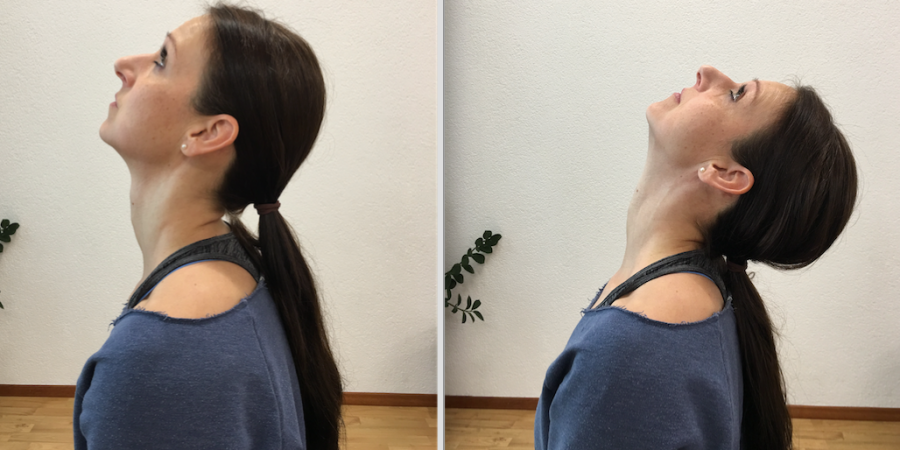A common observation among customers is Forward Head Posture (FHP). A neutral head position is very important for any client, especially when it comes to exercising. In order to do an exercise properly, it is important that his or her execution is good. And to have good exercise form, you need to have good posture during the exercise. The best way to achieve this is to correct static posture (standing/sitting). Then you perform the exercise – which is a dynamic posture.
A common finding in FHP is the so-called Upper Cross Syndrome = weak/inhibited neck flexors.
The following muscles are likely to be overactive or have limitations:
– Sternocleidomastoid muscle
– Scaleni muscles
– Levator scapulae muscle
– Suboccipital muscles
The scalene muscles and suboccipital muscles, which adapt to a smaller range of motion with high tone through the FHP, will inhibit the deep neck flexors.
The Scaleni muscles attach to rib 1 and rib 2 and a very common observation is that rib 1 is superior (further up) and cannot move inferior (downward) and so can move through the first rib Symptoms are produced in the arms/fingers and movement of the neck and shoulders is restricted. The suboccipital muscles adapt to this by becoming shorter.
There are now studies showing that one of the suboccipital muscles (rectus capitis posterior minor) is connected to the dura (the covering of the spinal cord). There are two possible mechanisms that can cause neurological dysfunction:
1. Direct mechanical damage to the nerve of the spinal cord
2. Collapse of the small veins near the spinal cord/blockage of the small veins
If you look at the cross-section of the spinal cord at the level of the first vertebra (atlas), you can see two major nerve pathways - these are the spinocerebellar tract and the spinothalamic tract.
The first system can be affected by traction and/or compression of the denticulatum. In this system, the signals are sent that determine the tone of the muscle and which also send information about the joint position (proprioception).
In the outer fibers of this tract are the "cables" that run to the lower part of the body, the pelvis, hips, legs, and feet. Having a dysfunction and/or imbalance in the upper cervical region can cause symptoms in the legs.
The second system, the spinothalamic tract, is also affected by the position/posture of the neck. In this tract are the signals sent for nociception/temperature. This is a possible explanation for symptoms down the legs without there being any findings from the lumbar spine/hip/or legs. This can potentially be corrected by treating the upper cervical region and neck posture.
Some effects of the Forward Head Posture are:
– Traction of the suprascapular nerve (this nerve provides innervation to the supraspinatus and infraspinatus muscles)
- Traction of a peripheral nerve usually leads to inhibition of the muscles innervated by this peripheral nerve.
A "dowager's hump" is a sign of chronic FHP. This causes dysfunction in the connection between the cervical and thoracic spine. The ligaments between the vertebrae and to some extent the capsules of the thoracic vertebrae are strained. Tension in the ligaments is often accompanied by tension and increased tone in the upper cervical spine extensors.
For every 2.5 cm of FHP, the compression in the lower cervical vertebrae increases by the equivalent of an additional head. Considering that the weight of the head is approximately 7% of body weight (BW) and a forward rotated shoulder girdle is approximately 14% of BW, a total of 21% of BW can compress the lower cervical vertebrae and upper thoracic spine.
This is something to keep in mind when doing Romanian deadlifts, Olympic snatches, deadlifts, etc., since you have 21% of your body weight and an external weight hanging from your neck and upper thoracic vertebrae.
This is especially important for women since women typically only have 60% of the strength of a man's neck extensors.
Entrapment of the greater suboccipital nerve high in the suboccipital region can also occur. This often manifests itself as a headache.
Th1-Th4 (upper thoracic spine) dysfunction. This region is home to the sympathetic nervous system, which controls the tone of the vessels in the neck, shoulders, arms, and hands. This is very important for the exchange of food metabolites etc. or in headaches where often the tone of the vessels is a possible background to the symptoms.
This can also be important in acute injuries with swelling to normalize the swelling by treating the nervous system.
Attend the YPSI Myorelease for Personal Trainers seminar in Brussels, Belgium in March 2017 to learn how to relax tight muscles and strengthen weak muscles to improve FHP. There you will learn the techniques for this as well as other techniques to optimize mobility, stability and flexibility and how to use YPSI Tool .
Image: Outstanding before'n'after from Swiss personal trainer Nadja Reinmann about improving neck extension after treatment by Dr. Peter Lundgren.

